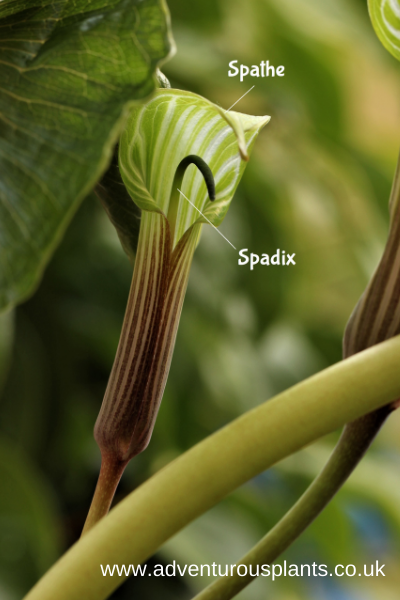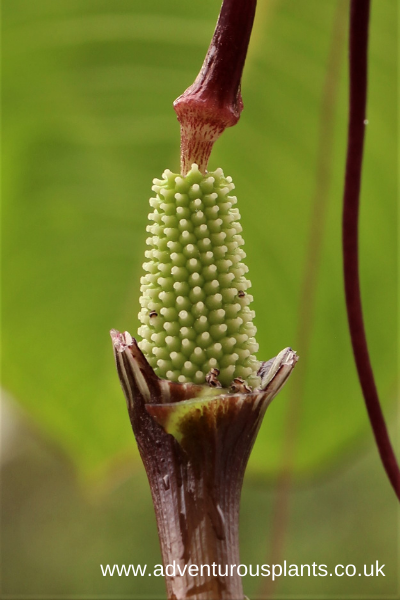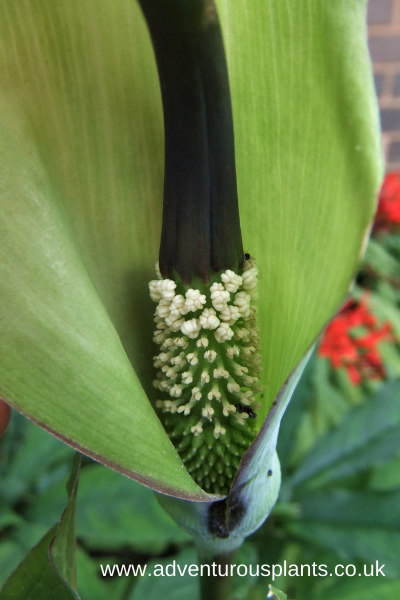How to pollinate Arisaema:
Arisaema are attractive members of the Araceae (or Aroid) plant family that are popular with growers for both their attractive foliage and often spectacular inflorescence. Whilst it is easy to think of the inflorescence as the ‘flower’, the true floral parts are actually located within this structure, and if you intend to set seed with your plants, it will help greatly if you know a few basic botanical structures and how to recognise them. This simple guide should arm the grower with all they need to know, along with how to pollinate your Arisaema plants.
An Arisaema inflorescence is made of two basic parts – the spathe and the spadix, and both can vary hugely in shape, colour and form. The spathe is a modified leaf, or bract, that surrounds and encloses the spadix.

The actual flowers are held on the spadix, and in order to see them, you’ll need to carefully fold back the spathe in order to get a good view. They certainly won’t look like a conventional flower to the untrained eye. An individual plant may be either male, female, or in some species contain a mixture of male or female flowers. And this is where an understanding of the botanical parts will help if you want to set seed – clearly if all your plants are male then you won’t be getting any seeds…
As an additional complication, an individual Arisaema plant can change sex year on year, and as far as I am aware, they are the only plant that is capable of doing this.
Confused? Read on and hopefully all will become clear!
The sex of an individual Arisaema plant is largely driven by the size of the tuber. A large tuber will contain a correspondingly large reserve of starchy food supplies, and it will be capable of sustaining the plant throughout it’s growing season, as well as having enough reserves to produce berries and seeds – all of which are energy expensive.
Conversely, a small tuber will likely either not flower, or produce male flowers. These male flowers release pollen which is needed to fertilise a female plant. This process does not place anywhere near as high an energy demand on the food reserves in the tuber, hence flowering from a smaller size.
It is common for a small tuber to make male flowers one year, then increase in size and flower again the following year with female flowers. Or the same can happen in reverse – female flowers and seeds can be produced which depletes the tuber and makes it smaller, with male flowers the following year. All of which can make it both fun and frustrating trying to produce Arisaema seed, depending on your point of view!
The following photos will help to identify the sex of your plants:


Some species produce bisexual inflorescences – both male and female flowers will be present, separated into two clusters on the spadix. In the case of bisexual plants, the female parts will ripen first before becoming unreceptive. After this the pollen is released from the male flowers. Consequently it is rare for an individual plant to set seed on it’s own as the phasing of the male and female flowers are not in sync. The photo below shows Arisaema tortuosum with female flowers at the bottom and the creamy coloured male flowers above.

Artificial Pollination Method:
In the wild, Fungus Gnats are the natural pollinators for Arisaema, and left to their own devices, it is perfectly possible for seed to be set in many species. Having said that, in my experience, some species seem shy to set seed without intervention from the grower. Fortunately it is relatively easy for the grower to pollinate their Arisaema, and in theory, it should simply be a case of transferring pollen from a male plant to the ovaries of a female plant. A soft paintbrush can be used, however, I have had great success with the following method and would always recommend this simple procedure:
1) Once a male flower has been identified, check to see if the pollen has been released. This should be visible as a powder on the flowers themselves or collecting in the bottom of the spathe tube.
2) Carefully place the inflorescence inside a drinking glass and shake the pollen into the glass. With care, you will not need to remove the inflorescence or damage the spathe, and so can continue to enjoy the flowering display.
3) Add a cm or two of water to the pollen in the glass and give a quick stir.
4) The pollen is hydrophobic and will be repelled away from the water and will stick to any surface it comes into contact with. Carefully pour the pollen and water mixture down the inside of a female inflorescence. The water will drain from the bottom of the spathe and the pollen will stick to the inside surfaces, including the stigma on the ovaries.
5) Leave nature to take it’s course! Hopefully a thorough and even distribution of pollen will have covered the female flowers and good fertilisation and seed set will be achieved.
Arisaema seeds will be ripe when the berries are red. The berries contain a natural germination inhibitor, so they will need to be removed from the berries and cleaned before sowing. It is best to leave the ripening infructescence attached to the plant unless the peduncle has fully withered away, in which case it can be removed and left to ripen elsewhere.
A few other notes:
1) There is always an exception to every rule – Arisaema flavum is self-fertile and a single flowering plant will go on to make fertile seeds on it’s own.
2) Some species are very capable of cross pollination, particularly those from Section Sinarisaema such as Arisaema consangeuineum, ciliatum and taiwanense, amongst others. If these species happen to grown together and flowering coincides, then the chance of cross-contamination is high. This has led to an unfortunte and highly confusing taxanomical mess when trying to identify many cultivated plants as they often show a mixture of traits from different species!
Garden-produced seeds from many plant societies, seed exchanges and commercial companies often contain cross pollinated seeds (inadvertently). If you want pure species, always hand pollinate your plants or purchase seeds from a reputable source who can guarantee hand pollination.
3) In rare cases, a single plant has been known to produce viable seed through the process of Apomixis. This is well beyond the scope of this short article, or even this website, but essentially it is the production of fertile seed through asexual means within the ovaries. I have had this occur with plants of Arisaema consanguineum ‘The Perfect Wave’, and have also heard reports of Apomixis occurring in Arisaema costatum. Such events are highly unusual.